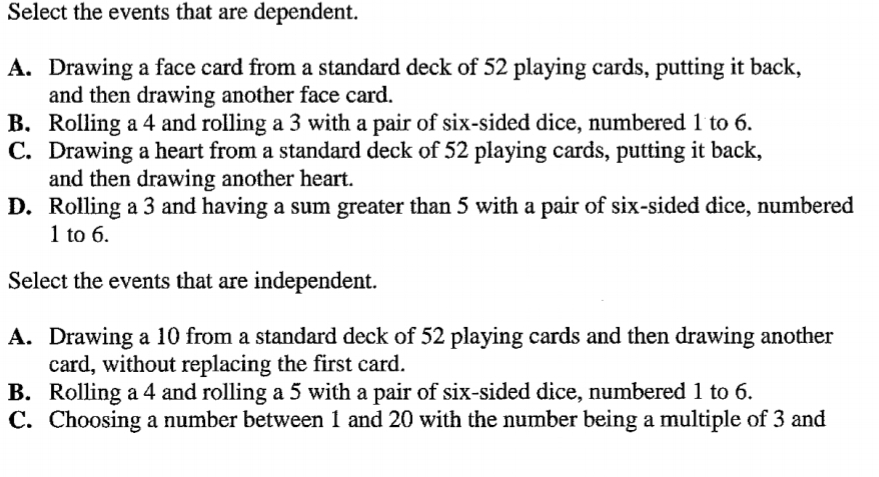Select the events that are dependent. A. Drawing a face card from a standard deck of 52 playing cards, putting it back, and then drawing another face card. B. Rolling a 4 and rolling a 3 with a pair of six-sided dice, numbered 1 to 6. C. Drawing a heart from a standard deck of 52 playing cards, putting it back, and then drawing another heart. D. Rolling a 3 and having a sum greater than 5 with a pair of six-sided dice, numbered 1 to 6. Select the events that are independent. A. Drawing a 10 from a standard deck of 52 playing cards and then drawing another card, without replacing the first card. B. Rolling a 4 and rolling a 5 with a pair of six-sided dice, numbered 1 to 6. C. Choosing a number between 1 and 20 with the number being a multiple of 3 and
Select the events that are dependent. A. Drawing a face card from a standard deck of 52 playing cards, putting it back, and then drawing another face card. B. Rolling a 4 and rolling a 3 with a pair of six-sided dice, numbered 1 to 6. C. Drawing a heart from a standard deck of 52 playing cards, putting it back, and then drawing another heart. D. Rolling a 3 and having a sum greater than 5 with a pair of six-sided dice, numbered 1 to 6. Select the events that are independent. A. Drawing a 10 from a standard deck of 52 playing cards and then drawing another card, without replacing the first card. B. Rolling a 4 and rolling a 5 with a pair of six-sided dice, numbered 1 to 6. C. Choosing a number between 1 and 20 with the number being a multiple of 3 and
Holt Mcdougal Larson Pre-algebra: Student Edition 2012
1st Edition
ISBN:9780547587776
Author:HOLT MCDOUGAL
Publisher:HOLT MCDOUGAL
Chapter11: Data Analysis And Probability
Section11.8: Probabilities Of Disjoint And Overlapping Events
Problem 1C
Related questions
Question
100%
I do not understand Dependant and Independant examples. Can you please explain.

Transcribed Image Text:Select the events that are dependent.
A. Drawing a face card from a standard deck of 52 playing cards, putting it back,
and then drawing another face card.
B. Rolling a 4 and rolling a 3 with a pair of six-sided dice, numbered 1 to 6.
C. Drawing a heart from a standard deck of 52 playing cards, putting it back,
and then drawing another heart.
D. Rolling a 3 and having a sum greater than 5 with a pair of six-sided dice, numbered
1 to 6.
Select the events that are independent.
A. Drawing a 10 from a standard deck of 52 playing cards and then drawing another
card, without replacing the first card.
B. Rolling a 4 and rolling a 5 with a pair of six-sided dice, numbered 1 to 6.
C. Choosing a number between 1 and 20 with the number being a multiple of 3 and
Expert Solution
This question has been solved!
Explore an expertly crafted, step-by-step solution for a thorough understanding of key concepts.
This is a popular solution!
Trending now
This is a popular solution!
Step by step
Solved in 2 steps

Knowledge Booster
Learn more about
Need a deep-dive on the concept behind this application? Look no further. Learn more about this topic, probability and related others by exploring similar questions and additional content below.Recommended textbooks for you

Holt Mcdougal Larson Pre-algebra: Student Edition…
Algebra
ISBN:
9780547587776
Author:
HOLT MCDOUGAL
Publisher:
HOLT MCDOUGAL

College Algebra (MindTap Course List)
Algebra
ISBN:
9781305652231
Author:
R. David Gustafson, Jeff Hughes
Publisher:
Cengage Learning

Holt Mcdougal Larson Pre-algebra: Student Edition…
Algebra
ISBN:
9780547587776
Author:
HOLT MCDOUGAL
Publisher:
HOLT MCDOUGAL

College Algebra (MindTap Course List)
Algebra
ISBN:
9781305652231
Author:
R. David Gustafson, Jeff Hughes
Publisher:
Cengage Learning